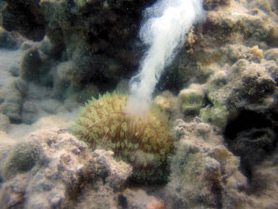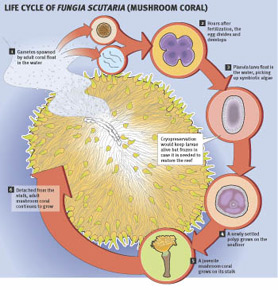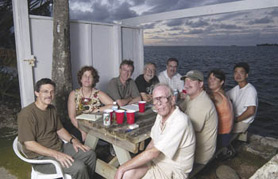Coral Tales
Freezing coral larvae at Coconut Island may provide a hedge against extinction

Send the kids to bed. It’s time for the Coconut Island sex show, Coral’s Secret Love.
On second thought, the sex lives of mushroom coral aren’t so secret given 20 years of research by two Hawaiʻi Institute for Marine Biology adjunct faculty. And the kids should stay up, because this work is about ensuring that they inherit a world with healthy coral reefs.
Science, like love, depends on a certain amount of serendipity. Once upon a time, David Krupp was performing a 24-hour experiment on Coconut Island for his doctoral dissertation. He returned from a dinner break to find the water was cloudy white in the tanks holding his Fungia scutaria (mushroom coral) specimens.
After a moment of panic—had he messed up the filtration system?—he noticed a tank without the coral was still clear. He took a sample of the milky liquid to the microscope and realized he was looking at eggs and sperm.
Thus Krupp’s 1983 paper in Coral Reefs was the first report of a tropical coral species spawning by broadcasting gametes into the water column. Similar observations were soon reported by a group working on Australia’s Great Barrier Reef. Until then, limited observation of coral behavior had led scientists to propose that most coral reproduce by brooding, in which fertilization occurs while the egg is in the parent.
"It was all fortuitous. It all had to do with timing," muses Krupp, now a professor at Windward Community College. He has continued to study mushroom coral through his affiliation with HIMB, on Coconut Island in Kāneʻohe Bay.
He has learned that the same coral (each "mushroom" is a single polyp, unlike branching and other corals that form colonies of many individuals) can broadcast sperm one season and eggs the next and vice versa. He knows that fertilization won’t be very successful if water temperatures rise much above the summer average of 28°C for Kāneʻohe Bay.
He’s captured on video 3-6 million eggs spewing from the corals’ mouths like a white lava fountain and observed larvae settle to the bottom after about nine days. And he knows spawning occurs one to four days after the full moon from late June through September or October.
 Life Cycle of Fungia scutaria (Mushroom Coral). Illustration by Kip Aoki. Click to enlarge.
Life Cycle of Fungia scutaria (Mushroom Coral). Illustration by Kip Aoki. Click to enlarge.Expertise like Krupp’s and the coral’s regularity is part of what drew Mary Hagadorn to the island. Hagadorn is working on preservation of coral larvae. "I looked at many marine stations before I selected HIMB," she says. "This is a wonderful facility to do this research." Coral is within easy reach. Scientists don’t have to travel two hours to and from the reef, camp aboard a boat or deal with diplomatic problems of doing science in a foreign country or with endangered species.
After spending two summers as adjunct faculty at Coconut Island, Hagedorn took a sabbatical from her position with the Smithsonian Institution in 2004 to focus on the freezing project. She talked five colleagues—the leaders in human fertilization and tissue preservation—to use personal vacation to join her for 10 days during the summer.
The collaborators included William Rall of the National Institutes of Health and Gregory Fahy of 21st Century Medicine, who developed the leading vitrification process for freezing mammalian embryos, and top chemists from the United States and Australia. After each day of experimenting, they gathered at a picnic table on the island’s seaward side, oblivious to ocean breezes and evening skies as they assessed their progress and discussed the next day’s approach.
Freezing of human and cow embryos has become routine. But coral larvae are tiny. Nothing is known about coral cryopreservation, she says. As part of the experimental process, the team attempts to remove water from the cells of the delicate larva, each about a tenth of a millimeter. A cryoprotectant, biological antifreeze if you will, is inserted to prevent formation of ice crystals that damage larvae during freezing and thawing.
Hagedorn is part of a Smithsonian group working on endangered species from elephants to fish. Three Caribbean corals will soon be added to the endangered species list, she says. Techniques developed in Hawaiʻi could be used to protect them and other species from extinction and even contribute to preservation of human tissue.
"Cryopreservation is an insurance policy for the future," Hagedorn says. Should coral ever become extinct, frozen larvae could be used to repopulate the reef. "It’s not the best way to save species," she emphasizes. Educating people to make good choices and preserving the natural environment are the best solutions, but this provides a hedge against extinction.
 On Coconut Island, the Smithsonian Institution’s Mary Hagadorn, second from left, convenes a pau hana debriefing of UH, mainland and international coral and cryopreservation experts attempting to freeze larvae as a hedge against extinction.
On Coconut Island, the Smithsonian Institution’s Mary Hagadorn, second from left, convenes a pau hana debriefing of UH, mainland and international coral and cryopreservation experts attempting to freeze larvae as a hedge against extinction.Krupp isn’t worried that mushroom coral will become extinct any time soon. They’re common in Kaneʻohe Bay and the same species is found in the Red Sea.
Still, there is reason for concern. Coral are subject to human pressures—pollution, sediment runoff, global warming—as well as natural events such as major floods that drench the bay with fresh water. After a major flood in 1965, coral in Kāneʻohe Bay didn’t recover until a sewage outfall in the bay was moved into open water in 1979. Recovery from a 1989 flood was much more rapid, but the reef is in decline again making it susceptible to being overgrown by invasive species.
Is population growth on shore to blame? Use of fertilizers? Increasing water temperatures? Sewage spills? Overfishing? UH scientsts are trying to answer those questions.
A winner of 2004 awards for both teaching and community service, Krupp and colleague Floyd McCoy also secured a $225,000 Harold K. L. Castle Foundation grant for activities that prepare students for environmental industry careers and contribute to the quality of life on Windward Oʻahu.
"The time is now to think about ways to protect the reef, minimize human impact and also look at ways to save the genetic heritage," Krupp says.
Coral Trivia
The birth of the first coral polyp is described in The Kumulipo, the Hawaiian creation hymn.
Mushroom coral was known to the ancient Hawaiians as ʻakoʻakoʻa kohe; its ridged skeleton was used to remove bristles from pig skin and polish canoes and other woodwork.
Zooxanthellae algae live symbiotically inside mushroom coral cells, where they generate energy-rich nutrients for the coral. The algae also produce a protein that gives the coral tentacles a florescent green color. A similar protein is produced by the jellyfish gene responsible for UH’s green transgenic mice. (Mālamalama July 1999).
Mushroom and other corals belong to the phylum cnidaria, stinging invertebrates that also include anemones and sea jellies.
What’s a reef worth?
Writing in the April 2004 issue of the University of Hawaiʻi Press journal Pacific Science, two Dutch economists peg the annual net value of the state’s 410,000 acres of reef in the main Hawaiian Islands at $360 million.
The overall asset value, without considering intrinsic but unquantifiable value, is nearly $10 billion. The research, funded by the National Oceanic and Atmospheric Administration through UH’s Coral Reef Initiative Research Program, considered tourism, real estate amenity, fisheries and biodiversity, including research grants.